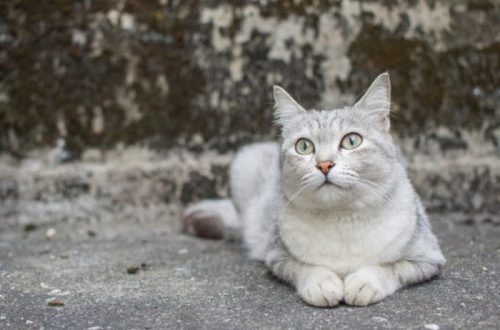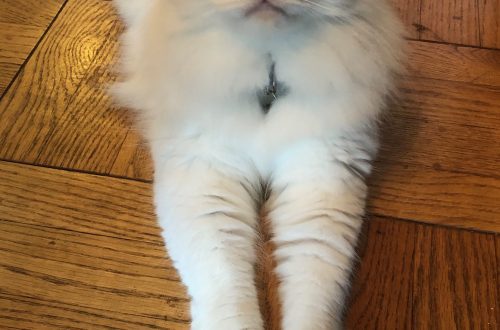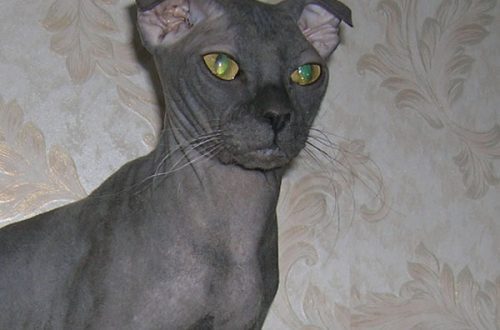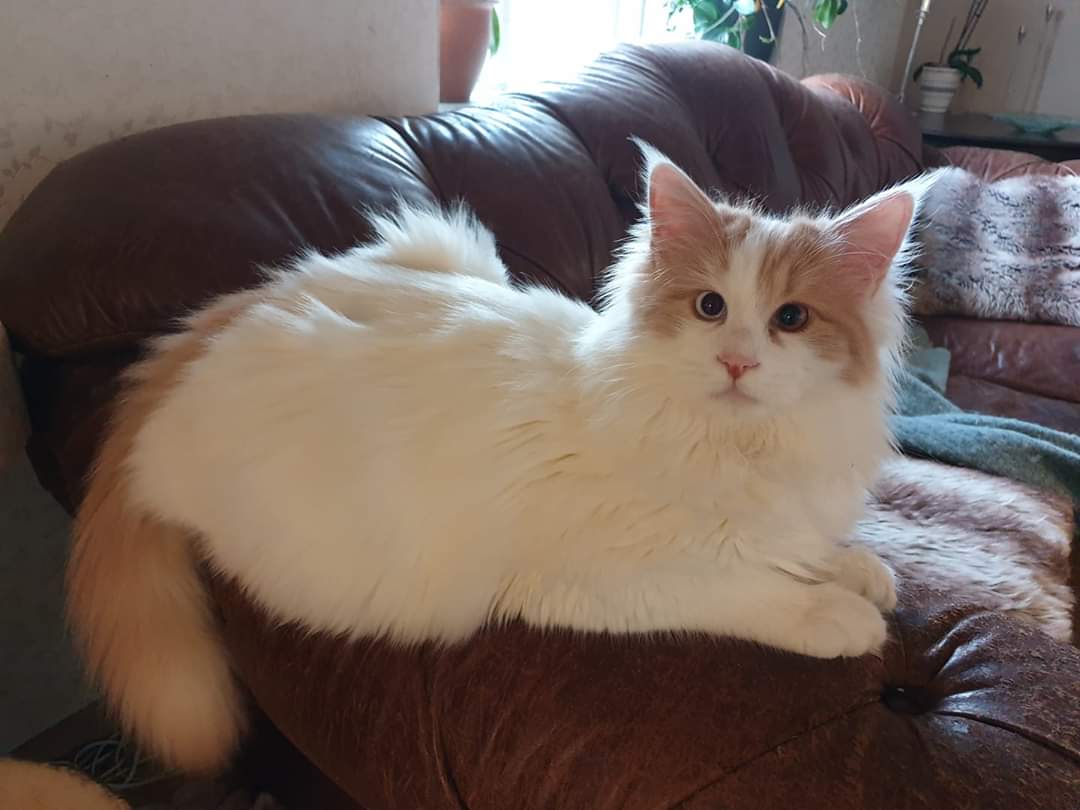
Turkish Van
Other names: Turkish Van cat
Turkish van is a white semi-longhair cat with colored spots on the head and a tail painted in a contrasting tone, bred since ancient times in the territories of the Armenian Highlands. All representatives of the breed are not afraid of water, and some willingly swim in shallow ponds and pools.
Contents
Characteristics of Turkish Van
| Country of origin | Turkey |
| Wool type | longhaired |
| Height | 35–40 cm |
| Weight | 4–9 kg |
| Age | 12–15 years old |
Basic moments
- Turkish Vans are cats with a reduced degree of allergenicity. Taking water procedures more often than other breeds, animals wash off the Fel d1 protein from the coat, which provokes sneezing and lacrimation in people with sensitive immunity.
- The Turkish van reaches its full physical flowering by 3-5 years. The same age is considered optimal for exhibiting a pet at exhibitions.
- The breed has a unique coat, reminiscent of delicate cashmere, which repels dust and water.
- Like most native breeds that developed in natural conditions, Turkish Van cats do not suffer from hereditary genetic diseases.
- In the homeland of the breed, in Turkey, only completely white individuals with eyes of different colors are quoted.
- Adult Turkish Vans are born talkers, and their meowing is not annoying, but very melodic.
- All representatives of the breed are enthusiastic gamers, chasing balls from early childhood to cat retirement, so from time to time the pet will have to buy new toys to replace those broken and loose with tenacious claws.
- European felinological associations do not yet register Turkish Vans with a solid white color, considering them a separate branch of the breed, however, they allow the crossing of Snow Whites with spotted cats.
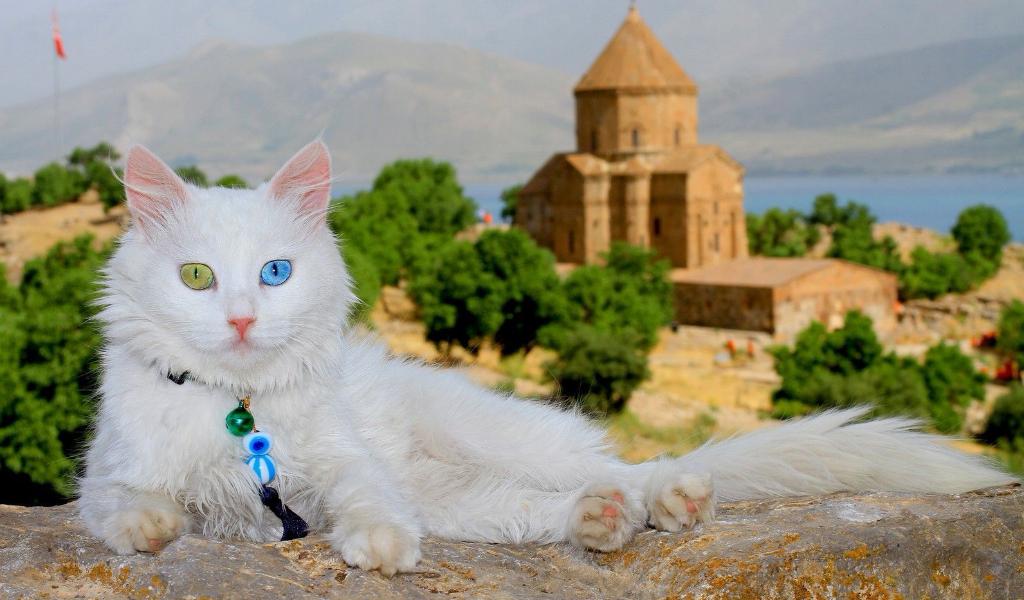
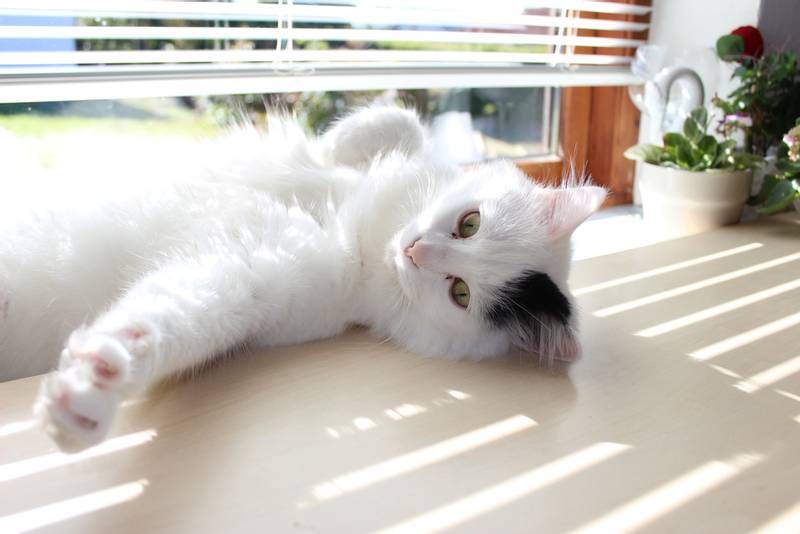
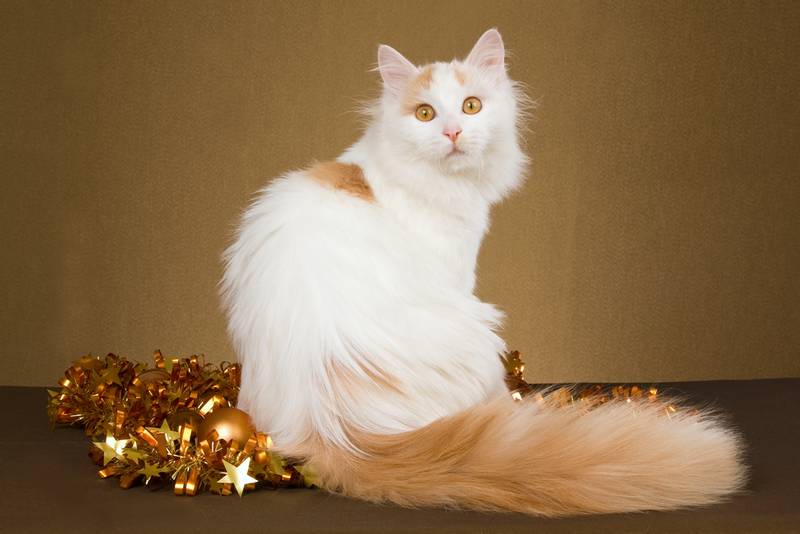
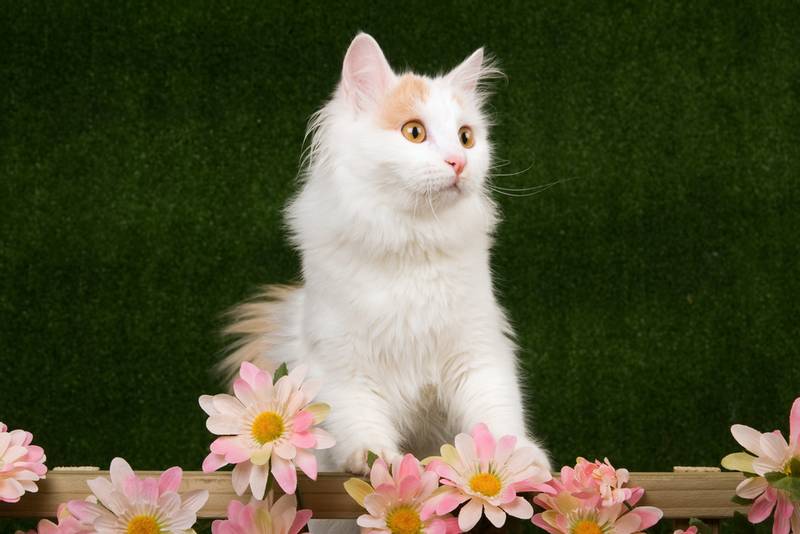
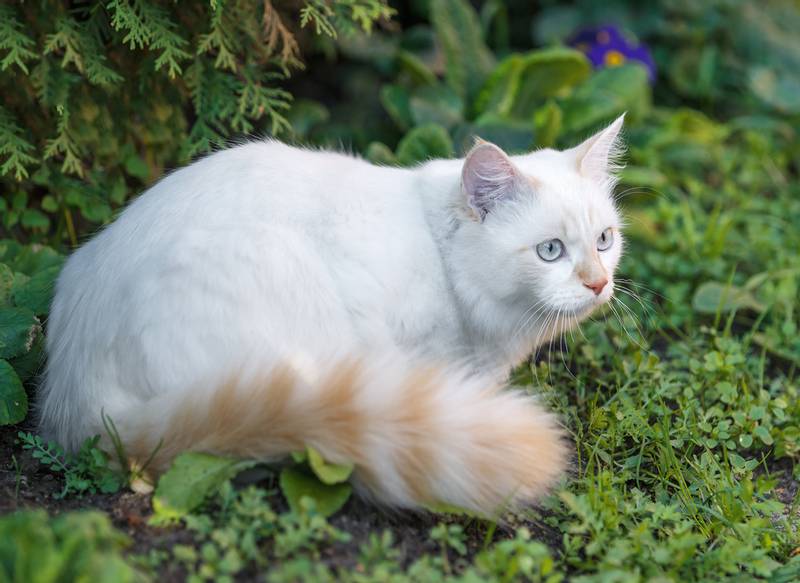
The Turkish Van cat is a moderately well-fed and sociable beauty who has a secret passion for water attractions and fishing. Looking at this fluffy imposing smart girl, it seems that nature created the animal exclusively for sitting on the hands of the owner and soft pillows in the Sultan’s chambers. But don’t judge by first impressions. In everyday life, Turkish Vans are picky, playful cats who prefer sports records to lazy comfort, and energy-intensive entertainment to boring strokes.
History of the Turkish Van breed
Images of white-haired cats with fluffy tails were found on the jewelry of the Urartu era, the disappeared state that occupied the territories of the Armenian Highlands. Modern felinologists consider Lake Van, which belonged to the possessions of ancient Armenia, and later passed to the Ottoman Empire, as the birthplace of the breed. It was in the vicinity of this reservoir that the cats, called “vana katu”, bred uncontrollably for thousands of years, fishing and mousekeeping.
In the Middle Ages, cats from the banks of Van entered Europe with crusaders and merchant caravans. True, the breed did not win wide recognition in the Old World, but there a new name stuck to its representatives – ring-tailed cats. As for the modern history of the Vans, it began in the middle of the 20th century, with the travel of the British journalist Laura Lushington. Making a trip to the former Ottoman Empire, the Englishwoman received a gift from local residents of two kittens, which they presented as the aboriginal Van Kedisi breed. Fluffy pets conquered the newly-made mistress by discovering an irrepressible craving for water and bathing, which are unusual for European cats. It is understood that this interesting feature prompted Lushington to return to Turkey again for an additional “batch” of cats, which later became the progenitors of all English Vans.
By 1969, Van Kedisi were fully bred in Europe, and at exhibitions they were simply called Turkish cats. And only in 1971, after the animals were included in the FIFe lists, a more detailed name appeared – the Turkish Van cat. In 1979, the purr was recognized by TICA, and in 1994 by the CFA. But in Turkey, swimmer cats have long been refused to be considered as a unique breed, which did not prevent local cat owners from keeping a whole litter of vans.
To date, the import of animals from the Republic of Turkey has been officially stopped, and the cats themselves have been declared a national treasure. Sometimes, of course, exceptions are allowed, but this happens almost at the government level. So if you are not a significant political figure, like Bill Clinton, to whom the Turks presented the sacred Van cat in 1996, count on fluffies born in the walls of domestic, European and American catteries.
An interesting fact: in Turkey, only individuals of a solid white color with heterochromia are extolled, while felinological commissions treat this variety of the breed with caution. And although the process of standardization of albino vans has already been launched by several associations, at exhibitions, animals with spots between the ears and a painted tail continue to be considered exemplary van cats.
Video: Turkish van
Turkish Van breed standard
The Turkish Van is a large-format breed capable of gaining between 6 and 9 kg. The increased volume of the silhouette and the massiveness of the skeleton are mainly distinguished by male individuals. Kittens are noticeably more elegant than their partners, so their weight does not exceed the bar of 6 kg. One of the Van’s defining exterior features is the fluffy tail, adorned with rims of peach or tortoiseshell hues, because of which the ancestors of the breed were once dubbed ring-tailed cats. Many animals also have a contrasting spot in the shoulder area. According to Muslim legend, this is the imprint of the hand of the Almighty, who stroked the Turkish van because he destroyed the mice that vilely perforated Noah’s Ark.
Turkish Van Head
The Turkish Van cat has a blunt wedge-shaped head. The profile of the animal is distinguished by minimal relief and a strong, well-marked chin.
Ears
Vans hold their ears straight and high. The ear cloth is rather large in size, with a well-rounded tip and a wide base. Inside the ear funnel is abundantly pubescent.
Nose
Only one type of earlobe color is allowed – flesh pink.
Turkish Van Eyes
Turkish Vans are big-eyed cats with light amber or blue irises. The preferred shape of the eyelid incision is oval, set slightly oblique. Severe heterochromia of the iris is not considered a defect.
Frame
The body of the Turkish Van cat, although not gigantic in size, looks impressive due to the excellently developed muscular corset. A strong neck and a massive chest also give a stylish imposing silhouette to the purr.
limbs
The correct van has not long, but not short legs with rounded paws. The skin on the paw pads has a delicate pinkish tone.
Tail
The tail is of medium length, pubescent with thin semi-long hair, giving it a resemblance to a brush. This part of the body looks especially impressive in the summer, when the animal changes its coat to a less fluffy one. Compared to the short summer hair on the cat’s body, the fluffy tail hair looks like a fan.
Wool
The Turkish Van is a cat with a semi-long, silky coat and no undercoat at all. The shortest hair grows on the shoulders and neck, the longest – in the tail and hips. Usually the density of the cover varies depending on the season: winter cat coats are thicker and denser, summer ones are more airy. In addition, there are Dutch and English breeding lines. The “Dutch” hair is less plentiful, while the British Vans have an increased degree of fluffiness.
Color
According to felinologists, the classic Turkish van is a white semi-longhair cat with a ring-shaped “print” on the tail, colored marks between the ears and sometimes a spot in the area of the shoulder blades. Contrasting “islands” on the purr’s head can be red, cream, black and blue. Animals with tabby marks are also not uncommon. Traditional tabby combinations are red, brown, cream and blue. Individuals may have tortie, torby, and diluted torby spots.
Sometimes, due to the play of genes, bi- and pa-color kittens are born, in which the proportion of white pigment on the coat is 50% or less. Specialists do not favor such colors, since they indicate outcrossing (impurities of blood of another breed).
Disqualifying vices
- Absence of colored spots on the head.
- Distinctly looming stop.
- Skeletal defects, including wrinkled tails, underdevelopment of fingers, and a flat chest.
- The total area of colored marks is more than 15% of the body.
The character of the Turkish van
A real Turkish van kedisi is a cat that is set up for close interaction with the owner and energetic entertainment. Flying around the apartment for a rolling ball or methodically torturing a crumpled newspaper, the cat will not interfere with either its impressive dimensions or your displeased looks. Moreover, this comrade will go out of his way to tempt the owner to play together or, at least, to throw rubber squeakers – the breed loves to fetch objects. Periodically, a climber wakes up in each animal, forcing him to remember that the house has unconquered peaks like a wardrobe, a refrigerator and a chest of drawers. Not to say that Turkish Van cats are such supermen, famously taking any height, but they climb on household appliances and furniture quite cheerfully.
If you want to look at the “hanging” cat, open the water in his presence. Any flow of life-giving moisture acts on the pet like a magnet, which can be torn off from which the animal can only be screwed on the tap. Fans of shooting funny videos in their own bathroom can be recommended to let a van go there, who will certainly make a “big splash”, relax from the heart in warm water and try to catch a jet. With country ponds and fountains – the same story, so if you breed fish in them, keep an eye on both. The Turkish-Armenian ancestors of Van cats were engaged in fishing at a professional level, and their domesticated descendants continue to “fish” in decorative ponds and indoor aquariums.
Turkish Vans like to keep the situation under control, so they almost always hang around a person. At the same time, they do not suffer from obsession and dependence on the master’s attention. Yes, the furry trickster is reluctant to play alone and prefers group entertainment, but it is not in his rules to annoy with claims. Often the behavior of a pet is determined by its gender. Cats, for example, are born bosses and leaders, shaking over their own independence. Males are more relaxed and positive, happy to let their partners steer.
A person for a Turkish van is not an unconditional authority, but an equal companion in games and a pleasant pastime. Don’t expect a fluffy grandee to sleepily recline on your hands and knees. In order to equalize his authority with the master’s, the van will certainly climb onto your back or shoulders and from a height will cast a contemptuous glance around those around you. By the way, about the views and facial expressions: the emotions of a pet are reflected not only in behavior, but also in the expression of the muzzle, so if the cat is dissatisfied with something, the owner will be the first to know about it. In addition, a Turkish van living in a family will definitely single out a pet in it, with which it will build a special line of behavior. The privileges that the confidant of the cat will receive are an affectionate rumbling in response to a momentary stroking (not to be confused with squeezing) and an instant reaction to the affectionate “kiss-kiss-kiss”.
Turkish Van Education and training
The breed is not offended by intellectual abilities. In addition, its representatives have excellent memory and ingenuity, allowing them to quickly establish cause-and-effect relationships. True, do not forget that the right Turkish van is always a slightly proud cat that cannot be forced to do anything, so build the learning process based on the individual characteristics of the pet. For example, if only a fluffy who has moved into an apartment refuses to use the tray and does his deeds on the mat, dragging him to the cat litter box by force is wrong. Better play on the natural flair of the purr by spraying a special spray on the tray like “My Place” or Ms. Kiss.
If the “flights” of the pet through cabinets and shelves are annoying, do not pull the animal back with every jump, but go towards it by building a play complex for the cat. Positive reinforcement works wonders too. Treat the van with a treat for every command he executes, and the furry rogue will quickly realize that the benefits of a job well done are much more solid than doing nothing. But it is better not to use punishment at all. The maximum that can hurt a cat is ignoring, so if the van refused to fulfill the requirement, pretend that nothing happened, but hide the treat and avoid communicating with the four-legged lazy person.
The control of feline gambling is far from the last thing in raising a Turkish Van. If you let the tailed bespredelschik have fun fetching as much as he wants, then very soon you will find yourself sitting among a pile of socks, hairpins, rags and thousands of other randomly scattered things. To prevent this from happening, teach the kitten that you can only play with special items, but not with the contents of the laundry basket and little things that accidentally come into view.
Maintenance and care
A Turkish Van kitten must be provided with standard “dowry” – a couch (basket), bowls for food and drink, as well as toys that kids love to drive around the floor. Don’t be surprised if at first you find a kitten anywhere but on its mattress. Even adult baths are slightly human-dependent, to say nothing of the crumbs taken from their mother and trying to hide from the big world in the owner’s bed or shoes. In connection with this feature of the breed, a little advice to breeders: before each start of the washing machine and taking out the garbage bag, do not forget to check if something lumpy and fluffy is sleeping in them.
Hygiene
In matters of cleanliness, Turkish Van cats are real perfectionists. After visiting the tray, the van will scrape and sniff the filler for several minutes, checking whether it has safely hidden its own waste products. So do not be lazy to clean the cat litter in a timely manner and do not save on filler – a self-respecting van will not go into a smelly tray and look for a cleaner place for “wet things”.
Turkish cats are combed once a week, first of all, smoothing the fur on the stomach, gradually moving on to working out the sides. A classic brush is suitable for combing, since the breed is devoid of tangled and tangled undercoat. As for washing wool, everything is simple here: Vans do not need to be persuaded to splash in the bath – most of them will gladly jump in there themselves. It is better to use cat cosmetics less often – once every 4-6 months. The healthy coat of the Turkish Van cat is able to self-clean and maintain a spectacular appearance, even if the owner does not use zoo shampoos and conditioners.
An obligatory procedure in the life of the Turkish Van is brushing the teeth, which are not entirely healthy and prone to the formation of tartar in the representatives of this clan. Western breeders recommend “disinfecting” the pet’s oral cavity daily, although breaks of a day or two are quite acceptable and will not cause serious damage to health. You should systematically check your pet’s ears, making sure that sulfur does not accumulate in them and ear mites do not settle. You can remove excess sulfur secretions with a cotton swab moistened with chlorhexidine or lubricated with cosmetic petroleum jelly. The claws of overly active vans are also shortened, but the cat will have to develop an adequate attitude to this process within several months.
Turkish Van Feeding
Western breeders prefer to feed Turkish Van cats with industrial super-premium and holistic food. To follow their example or not – each owner decides for himself. At the same time, it is important to remember that a balanced natural food is absorbed by the pet’s body no worse than the most expensive “drying”.
The daily diet of van kedisi does not differ from the menu of the average cat. Approximately 40% of the daily volume of food is allocated to protein components: lean sinewy meat, boiled fish fillet, sour-milk products. By the way, about fish: despite the fact that for the wild ancestors of Vans it was the basis of the menu, modern individuals should not be stuffed with this product. Of course, a couple of times a week a piece of mackerel or blue whiting should appear in the bowl of the animal, from which the bones have been removed, but raw river fish for the breed is taboo.
The required amount of fat in one serving is from 5% to 20%, depending on the degree of fatness of the animal. If the Turkish van is gaining too much weight, this is a reason to cut the calorie intake. Be aware that the breed has a tendency to become obese, which is easier to slow down in the early stages than to treat later. The amount of carbohydrates in food should also be minimal – the cat’s body spends too much resources on their breakdown.
From vegetables, carrots, pumpkin, broccoli and beets are useful for cats. But since the meowing brethren do not burn with desire to eat vegan dishes, you will have to be cunning and mix vegetable chips into meat porridge. The ideal option is to give the pet root vegetables and greens raw, so all the vitamins are preserved in them. If a cat has digestive problems, then it is better to boil carrots and cabbage. Abuse of plant foods is also not worth it, so if you notice that your pet has problems with stools and increased gas formation, the proportion of fiber in the diet should be minimized.
From time to time, Turkish vans are boiled porridge in meat broth, alternating rice and buckwheat. However, it is not recommended to make such dishes the basis of the diet – an excess of cereals provokes malfunctions of the pancreas and genitourinary systems. Sometimes it is useful to replace cereals with flax or buckwheat bran. Linseed and sesame oil, kelp, fish oil have proven themselves well as vitamin supplements. Trays with oats planted in the ground can also be a useful device – they are usually placed on a balcony or in a house. As soon as the seedlings hatch, it is necessary to indicate them to the Turkish van. In the future, the cat will already “graze” on its own near the oat field, eating young shoots rich in vitamins.
Health and disease of the Turkish Vans
Aboriginal cats, which include the Turkish Van, are less prone to genetic diseases than hybrid breeds, but they also have some ailments. For example, animals can suffer from hypertrophic cardiomyopathy, so if the cat has lost interest in games, has begun to cough hoarsely and breathes heavily with his tongue sticking out, it is better not to postpone a visit to the veterinarian. In some individuals, arterial thromboembolism may occur, the main symptom of which is complete or partial paralysis of the hind limbs.
Another weak point in the body of the Turkish Van is the teeth and gums. The former are prone to the accumulation of tartar, and the latter often become inflamed, causing pain to the cat, so do not skimp on toothpaste and do not be lazy to clean the pet’s mouth. Despite the increased physical activity, the breed is often obese, and this must also be considered. Moreover, in advanced cases, when the cat has managed to work up a lot of excess weight, it is better to put the animal not on an independently invented diet, but on a program developed by a veterinarian.
How to choose a Turkish Van kitten
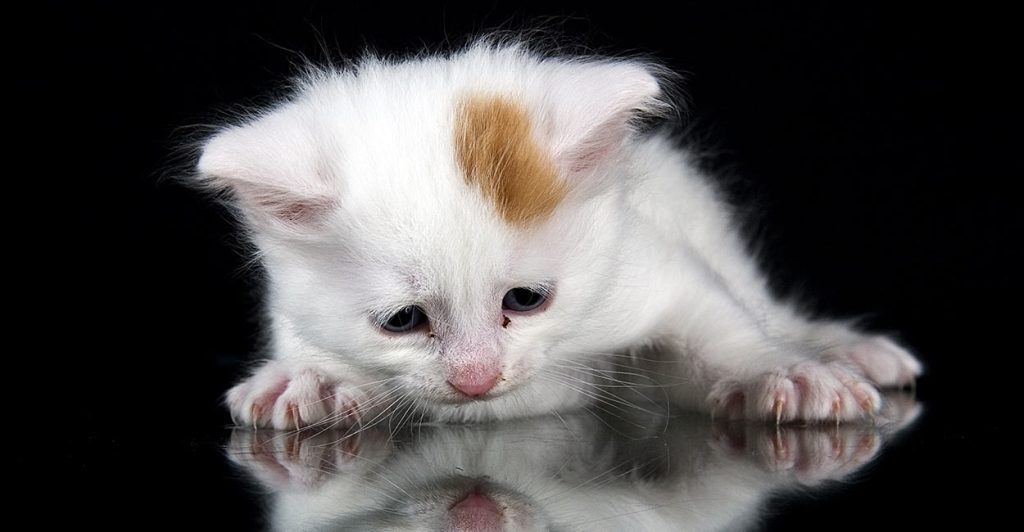

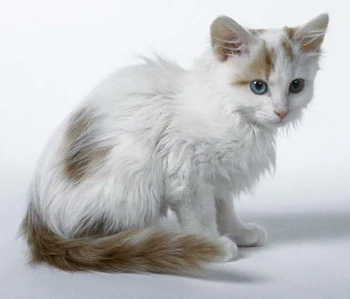

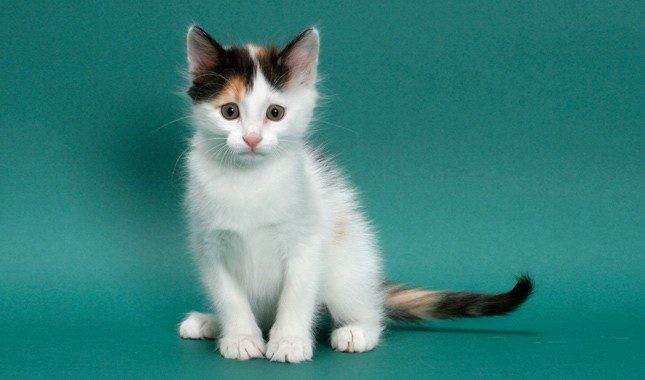

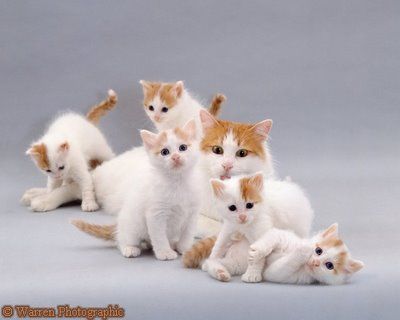

- There are almost no monobreed Turkish Van nurseries in Russia, and those that exist rarely put up worthy specimens for sale. If you have the opportunity to purchase a kitten abroad, do it there.
- The optimal age for moving a tiny van to a new family is three months. Taking kittens that are too small is a big risk, because the less the baby eats mother’s milk, the weaker his immunity.
- Ask the seller to show the pedigrees for the kittens, as well as their parents – this information is not hidden in official catteries.
- Carefully study the color of the animal, armed with the breed standard. Remember, a real Turkish Van is a completely white cat with small contrasting spots between the ears, a blaze on the forehead and a painted tail.
- Be extremely careful when acquiring all-white representatives of the breed, which is so praised in Turkey. Approximately 3% of them suffer from genetic deafness.
- If, against all odds, you want to buy an albino pet with heterochromic eyes, specify who his parents are. TICA recognizes and recommends white Vans only when they are born from a solid white and spotted sire – it is such “marriage alliances” that reduce the risk of hereditary deafness.
Turkish van price
The Turkish Van cat is a rare breed not only in Russia, but also in the world, so do not expect to get a kitten quickly, cheaply and close to home. It is also pointless to look at popular virtual bulletin boards. They sell mostly outbred animals that have colors similar to vans. As for the average price tag, in the nurseries of the USA and Canada it ranges from 800-1500 dollars (approximately 900 – 1650$). Vans from Local lines will cost a little less, but the choice of kittens from domestic breeders is still small, and there are decent queues of those who want to get a Turkish handsome man.





